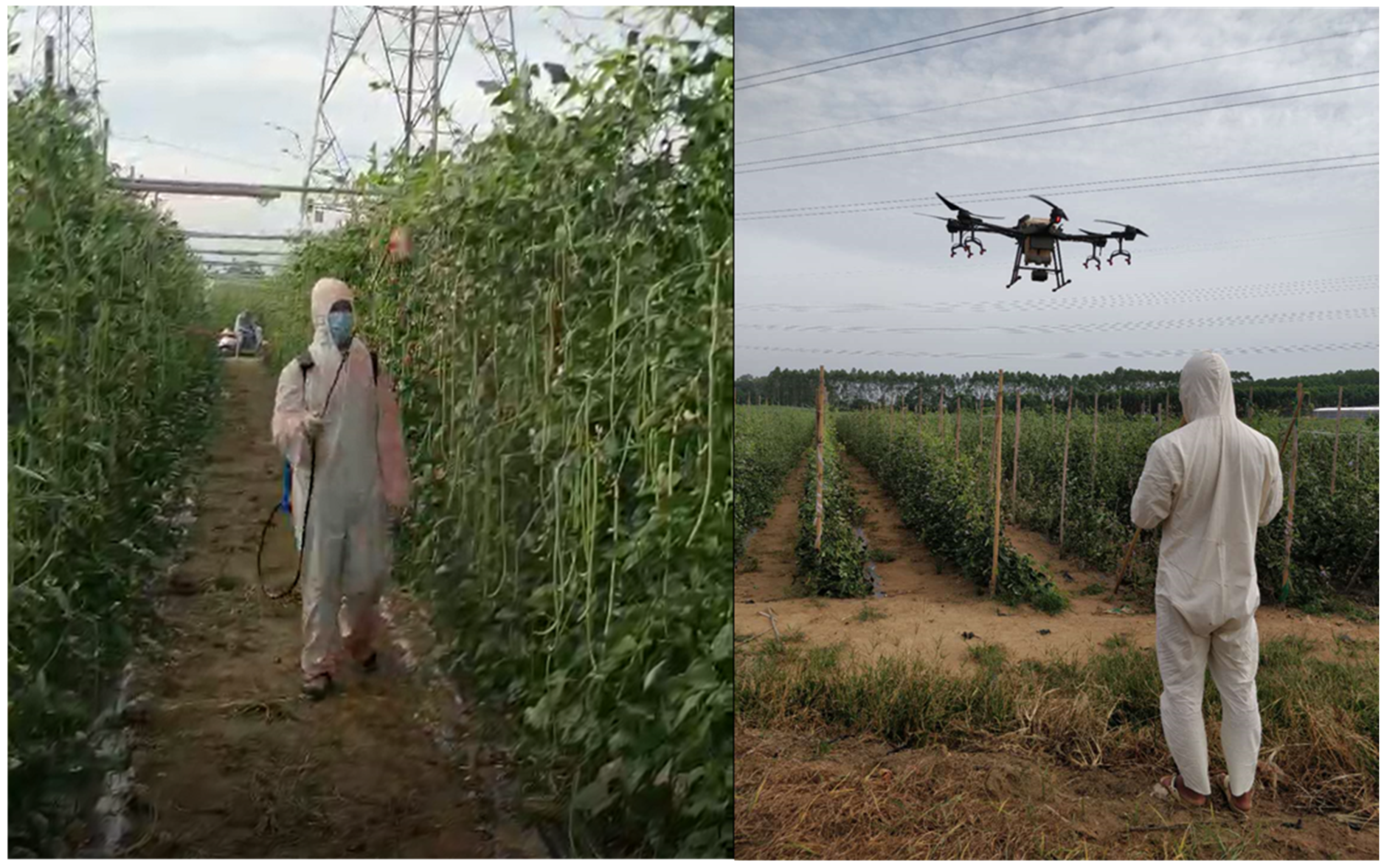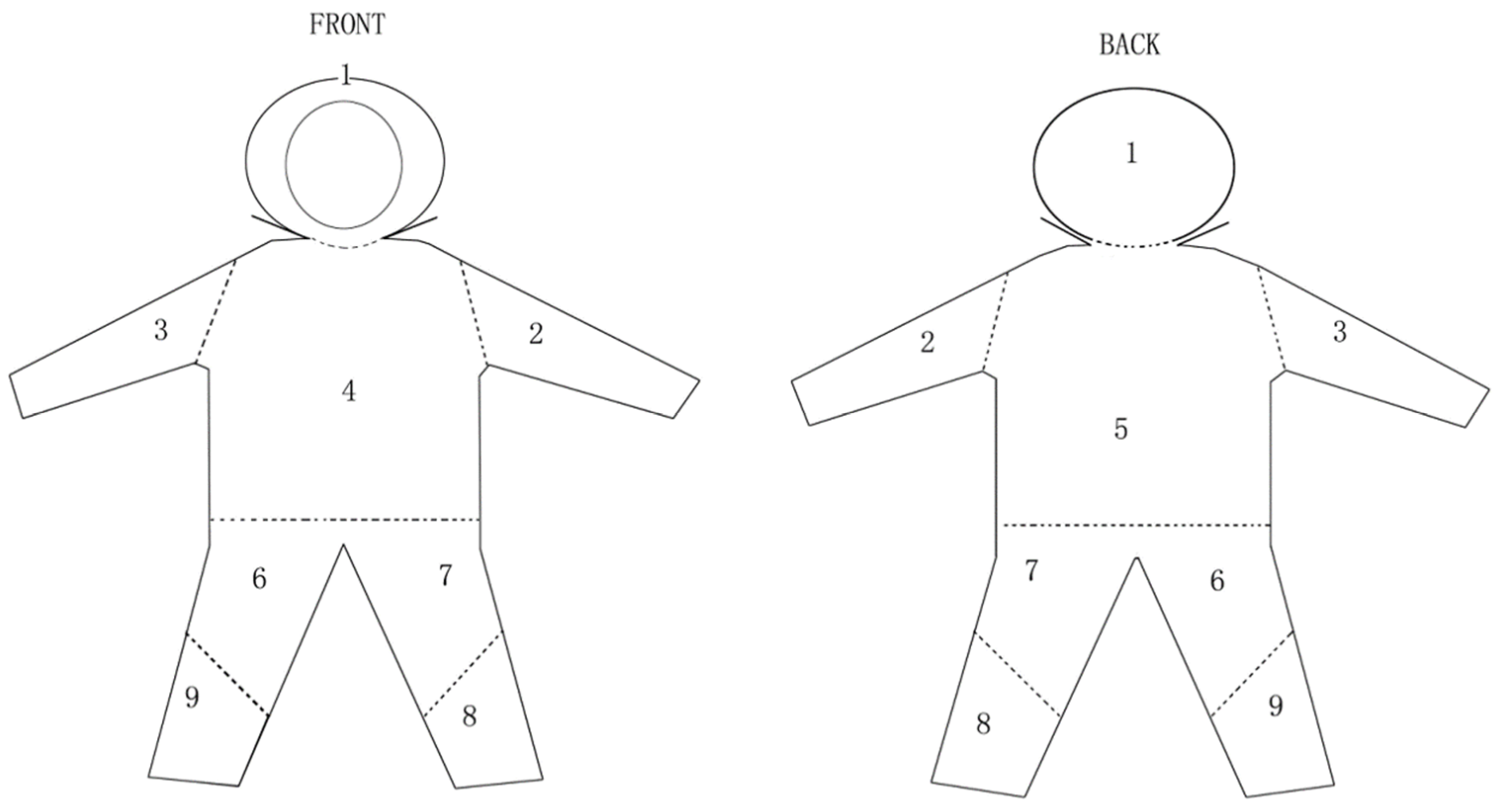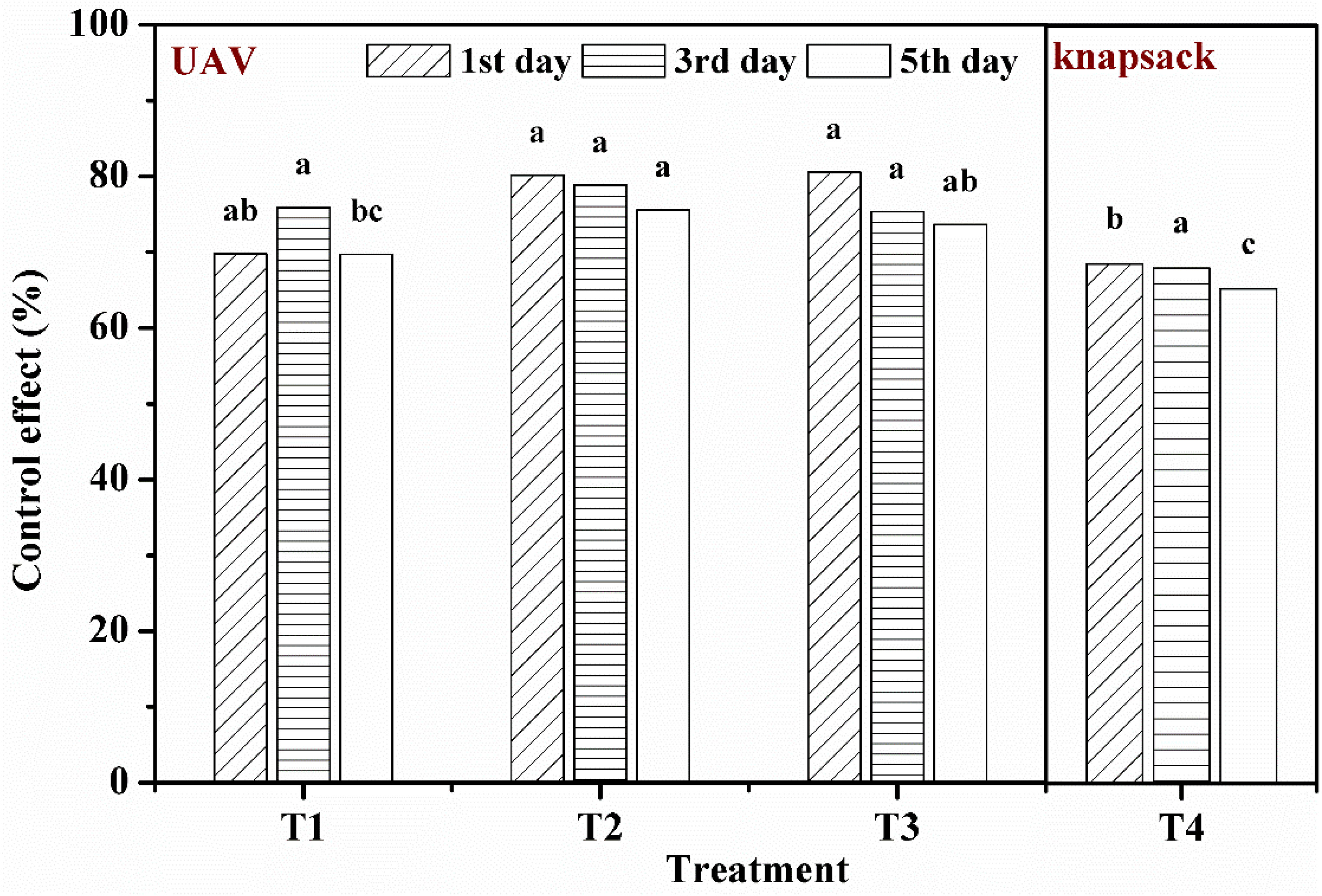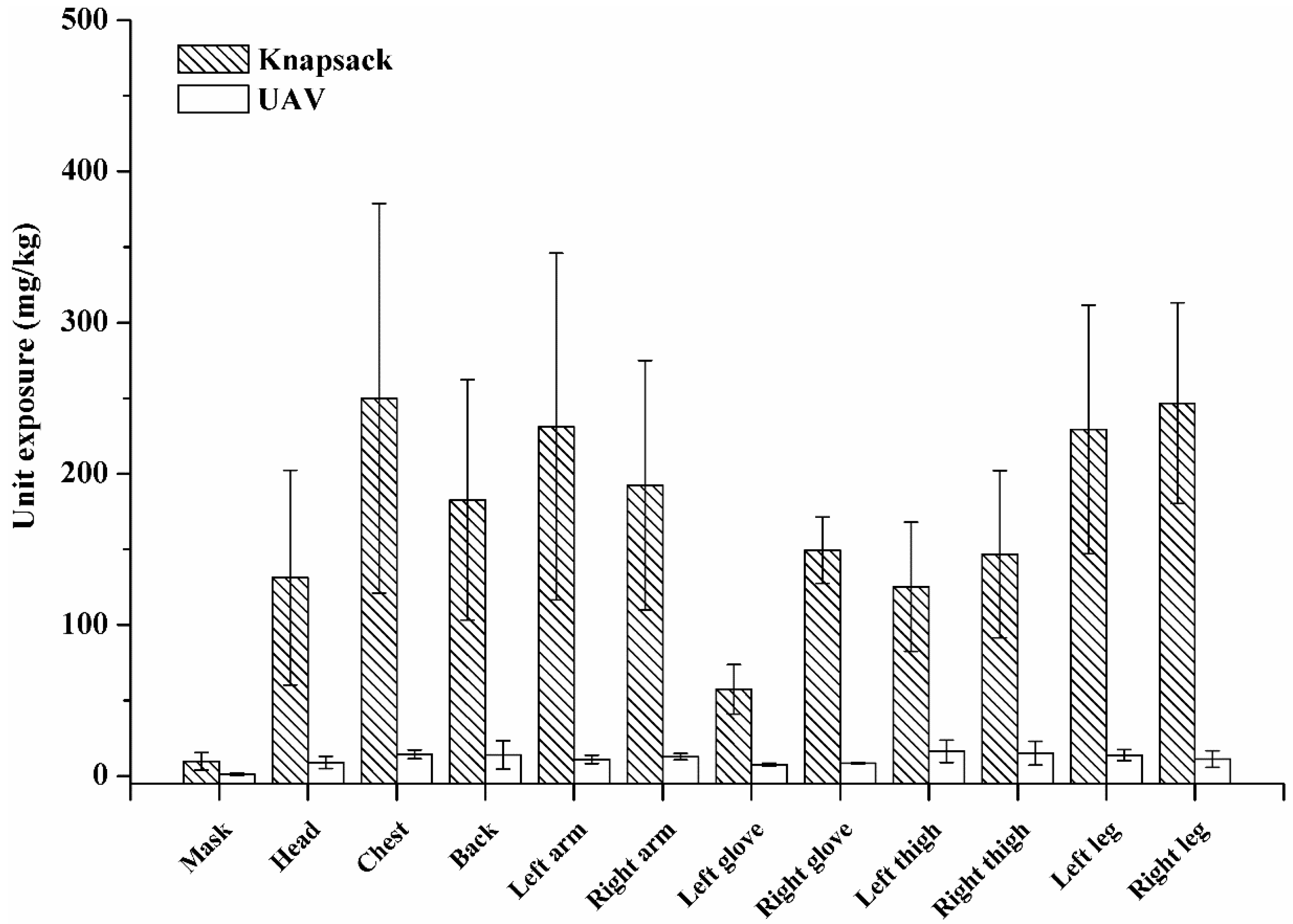Minimizing Occupational Exposure to Pesticide and Increasing Control Efficacy of Pests by Unmanned Aerial Vehicle Application on Cowpea
Abstract
1. Introduction
2. Materials and Methods
2.1. Reagents and Materials
2.2. Instruments
2.3. Field Trials
2.4. Exposure Determination of Operator to Pesticide
2.5. Chemical Analysis
2.6. Statistical Analysis
3. Results and Discussion
3.1. Control Effect against Thrips on Cowpea
3.2. Potential Dermal Exposure of Operators to Allura Red
4. Conclusions
Supplementary Materials
Author Contributions
Funding
Institutional Review Board Statement
Informed Consent Statement
Data Availability Statement
Conflicts of Interest
References
- Carvalho, F.P. Pesticides, environment, and food safety. Food Energy Secur. 2017, 6, 48–60. [Google Scholar] [CrossRef]
- Verger, P.J.P.; Boobis, A.R. Reevaluate pesticides for food security and safety. Science 2013, 341, 717–718. [Google Scholar] [CrossRef] [PubMed]
- Palis, F.G.; Flor, R.J.; Warburton, H.; Hossain, M. Our farmers at risk: Behaviour and belief system in pesticide safety. J. Public Health 2006, 28, 43–48. [Google Scholar] [CrossRef]
- Pinto, B.G.S.; Soares, T.K.M.; Linhares, M.A.; Ghisi, N.C. Occupational exposure to pesticides: Genetic danger to farmworkers and manufacturing workers–A meta-analytical review. Sci. Total Environ. 2020, 748, 141382. [Google Scholar] [CrossRef] [PubMed]
- Cao, L.; Chen, B.; Zheng, L.; Wang, D.; Liu, F.; Huang, Q. Assessment of potential dermal and inhalation exposure of workers to the insecticide imidacloprid using whole-body dosimetry in China. J. Environ. Sci. 2015, 27, 139–146. [Google Scholar] [CrossRef] [PubMed]
- Atabila, A.; Phung, D.T.; Hogarh, J.N.; Sadler, R.; Connell, D.; Chu, C. Dermal exposure of applicators to chlorpyrifos on rice farms in Ghana. Chemosphere 2017, 178, 350–358. [Google Scholar] [CrossRef] [PubMed]
- Adjrah, Y.; Dovlo, A.; Karou, S.D.; Eklu-Gadegbeku, K.; Agbonon, A.; De Souza, C.; Gbeassor, M. Survey of pesticide application on vegetables in the Littoral area of Togo. Ann. Agric. Environ. Med. 2013, 20, 715–720. [Google Scholar] [PubMed]
- Lin, Z.; Ji, X.; Pan, F.; Liang, Y.; Xiao, T.; Xie, S. Investigation and analysis of the current status of pesticide application in winter melon and vegetable pest control in Hainan Province, southern China. Acta Entom. Sin. 2016, 59, 1282–1290. [Google Scholar]
- Duan, Y.; Guan, N.; Li, P.; Li, J.; Luo, J. Monitoring and dietary exposure assessment of pesticide residues in cowpea (Vigna unguiculata L. Walp) in Hainan, China. Food Control 2016, 59, 250–255. [Google Scholar] [CrossRef]
- Boukar, O.; Belko, N.; Chamarthi, S.; Togola, A.; Batieno, J.; Owusu, E.; Haruna, M.; Diallo, S.; Umar, M.L.; Olufajo, O.; et al. Cowpea (Vigna unguiculata): Genetics, genomics and breeding. Plant Breed. 2019, 138, 415–424. [Google Scholar] [CrossRef]
- Iost Filho, F.H.; Heldens, W.B.; Kong, Z.; de Lange, E.S. Drones: Innovative technology for use in precision pest management. J. Econo. Entomol. 2020, 113, 1–25. [Google Scholar] [CrossRef] [PubMed]
- Qin, W.C.; Qiu, B.J.; Xue, X.Y.; Chen, C.; Xu, Z.F.; Zhou, Q.Q. Droplet deposition and control effect of insecticides sprayed with an unmanne.d aerial vehicle against plant hoppers. Crop Prot. 2016, 85, 79–88. [Google Scholar] [CrossRef]
- Lan, Y.; Chen, S. Current status and trends of plant protection UAV and its spraying technology in China. Int. J. Precis. Agric. Aviat. 2018, 1, 1–9. [Google Scholar] [CrossRef]
- Lan, Y.; Wang, G. Development situation and prospects of China’s crop protection UAV industry. Agric. Eng. Technol. 2018, 38, 17–27. (In Chinese) [Google Scholar]
- Zhang, S.; Qiu, B.; Xue, X.; Sun, T.; Gu, W.; Zhou, F.; Sun, X. Effects of crop protection unmanned aerial system flight speed, height on effective spraying width, droplet deposition and penetration rate, and control effect analysis on wheat aphids, powdery mildew, and head blight. Appl. Sci. 2021, 11, 712. [Google Scholar] [CrossRef]
- Ahmada, F.; Qiu, B.; Dong, X.; Ma, J.; Huang, X.; Ahmed, S.; Chandio, F.A. Effect of operational parameters of UAV sprayer on spray deposition pattern in target and off-target zones during outer field weed control application. Comput. Electron. Agr. 2020, 172, 105350. [Google Scholar] [CrossRef]
- Xue, X.; Tu, K.; Qin, W.; Lan, Y.; Zhang, H. Drift and deposition of ultra-low altitude and low volume application in paddy field. Int. J. Agric. Biol. Eng. 2013, 7, 23–28. [Google Scholar]
- Lou, Z.; Xin, F.; Han, X.; Lan, Y.; Duan, T.; Fu, W. Effect of unmanned aerial vehicle flight height on droplet distribution, drift and control of cotton aphids and spider mites. Agronomy 2018, 8, 187. [Google Scholar] [CrossRef]
- Qin, W.; Xue, X.; Zhang, S.; Gu, W.; Wang, B. Droplet deposition and efficiency of fungicides sprayed with small UAV against wheat powdery mildew. Int. J. Agric. Biol. Eng. 2018, 11, 27–32. [Google Scholar] [CrossRef]
- Chen, S.; Lan, Y.; Li, J.; Zhou, Z.; Jin, J.; Liu, A. Effect of spray parameters of small unmanned helicopter on distribution regularity of droplet deposition in hybrid rice canopy. Trans. Chin. Soc. Agric. Eng. 2016, 32, 40–46. [Google Scholar]
- Chen, P.; Ouyang, F.; Wang, G.; Qi, H.; Xu, W.; Yang, W.; Zhang, Y.; Lan, Y. Droplet distributions in cotton harvest aid applications vary with the interactions among the unmanned aerial vehicle spraying parameters. Ind. Crop Prod. 2021, 163, 113324. [Google Scholar] [CrossRef]
- Wang, G.B.; Lan, Y.B.; Qi, H.X.; Chen, P.C.; Hewitt, A.; Han, Y.X. Field evaluation of an unmanned aerial vehicle (UAV) sprayer: Effect of spray volume on deposition and the control of pests and disease in wheat. Pest Manag. Sci. 2019, 75, 1546–1555. [Google Scholar] [CrossRef] [PubMed]
- Chen, S.D.; Lan, Y.B.; Zhou, Z.Y.; Ouyang, F.; Wang, G.B.; Huang, X.Y.; Deng, X.L.; Cheng, S.N. Effect of droplet size parameters on droplet deposition and drift of aerial spraying by using plant protection UAV. Agronomy 2020, 10, 195. [Google Scholar] [CrossRef]
- Wang, G.; Han, Y.; Li, X.; Andaloro, J.; Chen, P.; Hoffmann, W.C.; Han, X.; Chen, S.; Lan, Y. Field evaluation of spray drift and environmental impact using an agricultural unmanned aerial vehicle (UAV) sprayer. Sci. Total Environ. 2020, 737, 139793. [Google Scholar] [CrossRef] [PubMed]
- Chen, S.; Lan, Y.; Li, J.; Zhou, Z.; Liu, A.; Mao, Y. Effect of wind field below unmanned helicopter on droplet deposition distribution of aerial spraying. Int. J. Agric. Biol. Eng. 2017, 10, 67–77. [Google Scholar]
- Hunter, J.E.; Gannon, T.W.; Rochardson, R.J.; Yelverton, F.H.; Leon, R.G. Coverage and drift potential associated with nozzle and speed selection for herbicide applications using an unmanned aerial sprayer. Weed Technol. 2020, 34, 235–240. [Google Scholar] [CrossRef]
- Chen, Y.; Hou, C.; Tang, Y.; Zhuang, J.; Lin, J.; Luo, S. An effective spray drift-reducing method for a plant-protection unmanned aerial vehicle. Int. J. Agric. Biol. Eng. 2019, 12, 14–20. [Google Scholar] [CrossRef]
- Richardson, B.; Rolando, C.A.; Kimberley, M.O.; Strand, T.M. Spray application efficiency from a multi-rotor unmanned aerial vehicle configured for aerial pesticide application. Trans. ASABE 2019, 62, 1447–1453. [Google Scholar] [CrossRef]
- Tang, Y.; Hou, C.; Luo, S.; Lin, J.; Yang, Z.; Huang, W. Effects of operation height and tree shape on droplet deposition in citrus trees using an unmanned aerial vehicle. Comput. Electron. Agric. 2018, 148, 1–7. [Google Scholar] [CrossRef]
- Meng, Y.; Su, J.; Song, J.; Chen, W.-H.; Lan, Y. Experimental evaluation of UAV spraying for peach trees of different shapes: Effects of operational parameters on droplet distribution. Comput. Electron. Agric. 2020, 170, 105282. [Google Scholar] [CrossRef]
- Xue, X.Y.; Lan, Y.B.; Sun, Z.; Chang, C.; Hoffmann, W.C. Develop an unmanned aerial vehicle based automatic aerial spraying system. Comput. Electron. Agric. 2016, 128, 58–66. [Google Scholar] [CrossRef]
- Koo, Y.M.; Bae, Y.H.; Seok, T.S.; Shin, S.K.; Park, H.J. Tail rotor design and thrust test for a roll-balanced agricultural unmanned helicopter. J. Biosy. Eng. 2010, 35, 302–309. [Google Scholar] [CrossRef][Green Version]
- Wang, G.; Lan, Y.; Yuan, H.; Qi, H.; Chen, P.; Ouyang, F.; Han, Y. Comparison of spray deposition, control efficacy on wheat aphids and working efficiency in the wheat field of the unmanned aerial vehicle with boom sprayer and two conventional knapsack sprayers. Appl. Sci. 2019, 9, 218. [Google Scholar] [CrossRef]
- Li, X.; Giles, D.K.; Niederholzer, F.J.; Andaloro, J.T.; Lang, E.B.; Watson, L.J. Evaluation of an unmanned aerial vehicle as a new method of pesticide application for almond crop protection. Pest Manag. Sci. 2021, 77, 527–537. [Google Scholar] [CrossRef] [PubMed]
- Xiao, Q.; Du, R.; Yang, L.; Han, X.; Zhao, S.; Zhang, G.; Fu, W.; Wang, G.; Lan, Y. Comparison of droplet deposition control efficacy on Phytophthora capsica and aphids in the processing pepper field of the unmanned aerial vehicle and knapsack sprayer. Agronomy 2020, 10, 215. [Google Scholar] [CrossRef]
- Xiao, J.; Chen, L.; Pan, F.; Deng, Y.; Ding, C.; Liao, M.; Su, X.; Cao, H. Application method affects pesticide efficiency and effectiveness in wheat fields. Pest Manag. Sci. 2020, 76, 1256–1264. [Google Scholar] [CrossRef]
- Zhan, Y.; Chen, S.; Wang, G.; Fu, J.; Lan, Y. Biological control technology and application based on agricultural unmanned aerial vehicle (UAV) intelligent delivery of insect natural enemies (Trichogramma) carrier. Pest Manag. Sci. 2021, 77, 3259–3272. [Google Scholar] [CrossRef]
- Lake, E.C.; David, A.S.; Spencer, T.M.; Wilhelm, V.L., Jr.; Barnett, T.W.; Abdel-Kader, A.A.; Cortes, A.C.; Acuna, A.; Mattison, E.D.; Minteer, C.R. First drone releases of the biological control agent Neomusotima conspurcatalis on Old World climbing fern. Biocontrol Sci. Technol. 2021, 31, 97–106. [Google Scholar] [CrossRef]
- Cao, L.; Cao, C.; Wang, Y.; Li, X.; Zhou, Z.; Li, F.; Yan, X.; Huang, Q. Visual Determination of potential dermal and inhalation exposure using Allura Red as an environmentally friendly pesticide surrogate. ACS Sustain. Chem. Eng. 2017, 5, 3882–3889. [Google Scholar] [CrossRef]
- Gao, S.; Wang, G.; Zhou, Y.; Wang, M.; Yang, D.; Yuan, H.; Yan, X. Water-soluble food dye of Allura Red as a tracer to determine the spray deposition of pesticide on target crops. Pest Manag. Sci. 2019, 75, 2592–2597. [Google Scholar] [CrossRef] [PubMed]
- Zhang, Y.; Guo, W.; Chen, H.; Gao, J.; Xu, Z.; Tao, L.; Li, Z.; Xu, W. Spinetoram confers its cytotoxic effects by inducing AMPK/mTOR-mediated autophagy and oxidative DNA damage. Ecotoxicol. Environ. Saf. 2019, 183, 109480. [Google Scholar] [CrossRef]
- Choi, H.; Moon, J.K.; Kim, J.H. Assessment of the exposure of workers to the insecticide imidacloprid during application on various field crops by a hand-held power sprayer. J. Agric. Food Chem. 2013, 61, 10642–10648. [Google Scholar] [CrossRef]
- Hughes, E.A.; Flores, A.P.; Ramos, L.M.; Zalts, A.; Glass, C.R.; Montserrat, J.M. Potential dermal exposure to deltamethrin and risk assessment for manual sprayers: Influence of crop type. Sci. Total Environ. 2008, 391, 34–40. [Google Scholar] [CrossRef] [PubMed]
- Hughes, E.A.; Zalts, A.; Ojeda, J.J.; Flores, A.P.; Glass, R.C.; Montserrat, J.M.; Montserrat, J.M. Analytical method for assessing potential dermal exposure to captan, using whole body dosimetry, in small vegetable production units in Argentina. Pest Manag. Sci. 2006, 62, 811–818. [Google Scholar] [CrossRef] [PubMed]
- Nuyttens, D.; Braekman, P.; Windey, S.; Sonck, B. Potential dermal pesticide exposure affected by greenhouse spray application technique. Pest Manag. Sci. 2009, 65, 781–790. [Google Scholar] [CrossRef]
- An, X.; Liu, X.; Jiang, J.; Lv, L.; Wang, F.; Wu, S.; Zhao, X. Exposure risks to pesticide applicators posed by the use of electric backpack sprayers and stretcher-mounted sprayers in orchards. Hum. Ecol. Risk Assess. 2020, 26, 2288–2301. [Google Scholar] [CrossRef]




| Treatment | Spraying Equipment | Pesticide Dosage (mL/ha) a | Water Used (L/ha) | Flight Height (m) | Flight Speed (m/s) | Flow Velocity (L/min) |
|---|---|---|---|---|---|---|
| T1 | UAV | 300 | 22.5 | 2 | 2.4 | 1.28 |
| T2 | UAV | 300 | 30 | 2 | 1.8 | 1.28 |
| T3 | UAV | 300 | 37.5 | 2 | 1.5 | 1.35 |
| T4 | knapsack | 300 | 600 | – | – | – |
| Treatment | Spraying Equipment | Control Effect (%) * | ||
|---|---|---|---|---|
| 1st Day | 3rd Day | 5th Day | ||
| T1 | UAV | 69.79 ab | 75.92a | 69.73 bc |
| T2 | UAV | 80.15 a | 78.86 a | 75.61 a |
| T3 | UAV | 80.58 a | 75.35 a | 73.68 ab |
| T4 | knapsack | 68.55 b | 67.98 a | 65.23 c |
| Body Region | Operator Exposure (mg/kg) | |||||
|---|---|---|---|---|---|---|
| Op. A a Mean | Op. A SD | Op. B a Mean | OP. B SD | Op. C a Mean | Op. C SD | |
| Mask | 13.68 | 4.66 | 5.75 | 3.91 | 1.08 | 0.78 |
| Head | 192.42 | 16.61 | 70.11 | 33.62 | 8.95 | 3.92 |
| Chest | 358.40 | 47.37 | 141.34 | 62.66 | 14.39 | 2.91 |
| Back | 239.53 | 62.02 | 125.84 | 47.37 | 13.91 | 9.34 |
| Left arm | 326.79 | 48.85 | 135.57 | 55.26 | 10.89 | 2.80 |
| Right arm | 259.60 | 43.95 | 125.24 | 38.79 | 12.82 | 2.02 |
| Left glove | 64.78 | 17.79 | 50.02 | 13.78 | 7.49 | 0.88 |
| Right glove | 158.65 | 25.55 | 140.01 | 16.94 | 8.52 | 0.28 |
| Left thigh | 161.41 | 23.30 | 89.06 | 10.76 | 16.38 | 7.32 |
| Right thigh | 190.70 | 23.68 | 102.84 | 35.80 | 15.08 | 7.83 |
| Left leg | 292.33 | 67.25 | 166.58 | 23.30 | 13.79 | 3.67 |
| Right leg | 257.88 | 55.90 | 235.49 | 86.84 | 11.21 | 5.51 |
| Total exposure | 2516.17 | 28.18 | 1387.86 | 238.46 | 134.51 | 38.99 |
Publisher’s Note: MDPI stays neutral with regard to jurisdictional claims in published maps and institutional affiliations. |
© 2021 by the authors. Licensee MDPI, Basel, Switzerland. This article is an open access article distributed under the terms and conditions of the Creative Commons Attribution (CC BY) license (https://creativecommons.org/licenses/by/4.0/).
Share and Cite
Yan, X.; Zhou, Y.; Liu, X.; Yang, D.; Yuan, H. Minimizing Occupational Exposure to Pesticide and Increasing Control Efficacy of Pests by Unmanned Aerial Vehicle Application on Cowpea. Appl. Sci. 2021, 11, 9579. https://doi.org/10.3390/app11209579
Yan X, Zhou Y, Liu X, Yang D, Yuan H. Minimizing Occupational Exposure to Pesticide and Increasing Control Efficacy of Pests by Unmanned Aerial Vehicle Application on Cowpea. Applied Sciences. 2021; 11(20):9579. https://doi.org/10.3390/app11209579
Chicago/Turabian StyleYan, Xiaojing, Yangyang Zhou, Xiaohui Liu, Daibin Yang, and Huizhu Yuan. 2021. "Minimizing Occupational Exposure to Pesticide and Increasing Control Efficacy of Pests by Unmanned Aerial Vehicle Application on Cowpea" Applied Sciences 11, no. 20: 9579. https://doi.org/10.3390/app11209579
APA StyleYan, X., Zhou, Y., Liu, X., Yang, D., & Yuan, H. (2021). Minimizing Occupational Exposure to Pesticide and Increasing Control Efficacy of Pests by Unmanned Aerial Vehicle Application on Cowpea. Applied Sciences, 11(20), 9579. https://doi.org/10.3390/app11209579






